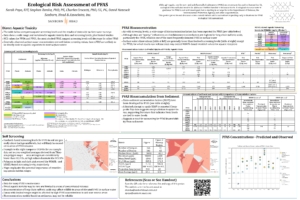Although regulations for per– and poly-fluoroalkyl substances (PFAS) are at present focused on human health, ecological risks will also need to be addressed within baseline risk assessments. Ecological risk assessment guidance for PFAS is not well developed but is starting to emerge from the Department of Defense, the Environmental Protection Agency, and other organizations.
This poster presents and discusses some considerations and observations regarding early indications for PFAS ecological risk assessment. Included are the results of a literature review conducted to identify the types of aquatic plants and animals likely to be affected by PFAS present in surface water systems and to compile toxicity reference values and bioconcentration factors for these biota. Predictive modeling is applied to estimate bioaccumulation impact. Also addressed is the potential of focused PFAS sampling in contaminant release areas to overemphasize average exposure across habitat areas.
Ecological Risk Assessment of PFAS (click to download)

CITATIONS
- Guidance for Assessing the Ecological Risks of PFASs to Threatened and Endangered Species at Aqueous Film Forming Foam-Impacted Sites, SERDP Project ER18-1614, prepared by Geosyntec Consultants (Jason Conder, Jennifer Arblaster, and Emily Larson) and the Colorado School of Mines (Juliane Brown and Chris Higgins), July 2019.
- Approach for Assessing PFAS Risk to Threatened and Endangered Species, SERDP Project ER18-1653, prepared by Aracadis US Inc. (Craig Divine, Jean Zodrow, Meredith Frenchmeyer, Katie Dally, Erin Osborn, and Paul Anderson), March 2020.
- PFAS Technical and Regulatory Guidance Document, prepared by the Interstate Technology Regulatory Council (ITRC) PFAS Team, April 2020.
- Development of Surface Water Screening Levels for PFOA and PFOS Based on the Protection of Human Health, prepared by the Center for Environmental & Human Toxicology, University of Florida (Leah Stuchal, Ph.D. and Stephen M. Roberts, Ph.D.), 2019.
- Human Health-based Water Quality Standards Technical Support Document, Water Quality Standard Amendments – Minn. R. chs 7050 and 7052 (Final), prepared by Minnesota Pollution Control Agency, 2017.
- Investigation of Levels of Perfluorinated Compounds in New Jersey Fish, Surface Water, and Sediment, prepared by the New Jersey Department of Environmental Protection, Division of Science, Research, and Environmental Health, June 2018 (updated April 2019).
- Aquatic plant, Weight Weight/Dry Weight (WW/DW) ratio = approximately 16
Sampling Submersed Aquatic Plant Biomass: Fresh vs. Dry Weight, prepared by Geosystems Research Institute, Mississippi State University (Gray Gurnage), February 2022.
- Fish WW/DW = approximately 5
Amchitka Radionuclide Data Set, Wet to Dry Weight Conversions for Biota from Amchitka and Kiska, prepared by Consortium for Risk Evaluation with Stakeholder Participation (CRESP), March 2006.
- Aquatic crustacean WW/DW = approximately 4
Lin Y, Gao Y, Li A, Wang L, Ai Z, Xiao H, Li J, Li X. Improvement of Pacific White Shrimp (Litopenaeus vannamei) Drying Characteristics and Quality Attributes by a Combination of Salting Pretreatment and Microwave.” Foods. 2022; 11(14):2066. https://doi.org/10.3390/foods11142066
- An Assessment of Contaminants of Emerging Concern in Chesapeake Bay, MD and Charleston Harbor, SC, prepared by National Status and Trends, Mussel Watch Program (Dennis Apeti, Ed Wirth, Andrew K. Leight, and Emily Pisarski), 2018.




